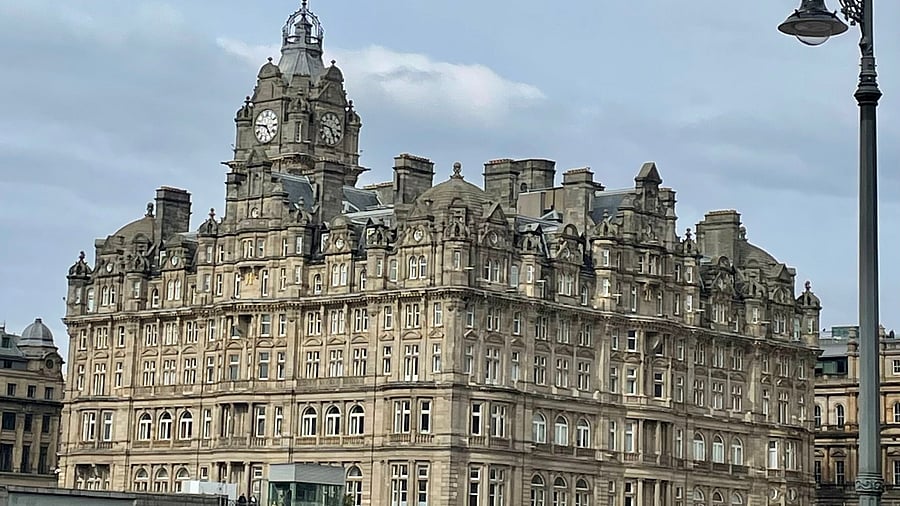
The Balmoral Hotel where JK Rowling famously rented a suite to finish writing 'Harry Potter and the Deathly Hallows'.
Credit: Photo by author.
History, culture, architecture, festivals, attractions, cafés, and restaurants — Edinburgh has it all. The capital of Scotland since the 15th century, Edinburgh is one of the world’s most beautiful cities.
The magnificent Edinburgh Castle, home to Scotland’s crown jewels, stands guard over the medieval Old Town and the elegant Georgian New Town. Closes and wynds coexist with gardens and monuments, ensuring that Scotland’s small, hilly capital has a charm all its own.
Edinburgh Castle, located on the plug of an extinct volcano, dominates the city’s skyline. St Margaret’s Chapel, its oldest section, dates to the 12th century, while the Scottish National War Memorial was built after World War I. Over the centuries, it has played many roles: a royal residence, a treasury, a military fortress, a mint, a prison, an arsenal, and a national archive.
Jenny McAdam, the walking tour guide, takes us on a tour of the “defender of the nation,” which includes all the highlights: the Royal Palace, the Half Moon Battery, Mons Meg, the One O’Clock Gun, the regimental museums, and the exquisite Queen’s Embroideries, created by Mary, Queen of Scots, during her exile in England.
The Royal Mile runs between two important locations, Edinburgh Castle and the Palace of Holyroodhouse, and derives its name from the fact that it used to be the path of the monarch’s procession. Located within a World Heritage site, the Royal Mile offers a range of cultural and historical options — to be explored on your own or via a walking tour.
St Giles’ Cathedral has been standing tall on the Royal Mile since the 12th century and stands out with its gorgeous architecture, including a late-Gothic nave, a 15th-century crown tower, and beautiful stained-glass windows. McAdam points out the Thistle Chapel, which continues to be used by the Knights of the Thistle, Scotland’s chivalric order, and the Heart of Midlothian, a heart-shaped pattern of stones on the pavement outside, symbolising Scottish resilience.
The Royal Mile has much more to offer: the Palace of Holyroodhouse, the official Royal Residence in Edinburgh, where the bedchamber of Mary, Queen of Scots, takes centre stage; Parliament House, built between 1632 and 1639; the National Library of Scotland, where philosopher David Hume was once a librarian; Mercat Cross, the focal point of the Scottish Enlightenment; and Gladstone’s Land, a 500-year-old high tenement house that showcases Edinburgh life during that period. The Real Mary King’s Close, which was recently named the UK’s number one tourist attraction, is shrouded in myths and mysteries and showcases the illness and misery that plagued the city in the 16th and 17th centuries.
“The labyrinth-like cluster of closes, connected by small alleys and walkways, was named for Mary King, a merchant burgess who lived here in the 17th century,” McAdam says. Since then, the warren of homes and passageways has become synonymous with tales of hauntings, murders, and plague deaths.
The Royal Mile also showcases Edinburgh’s literary side. Anointed the world’s first UNESCO City of Literature in 2004, it has a long list of authors connected to it: Robert Burns, Walter Scott, Robert Louis Stevenson, and Muriel Spark in the past, to J M Barrie, Irvine Welsh, Kenneth Grahame, Ian Rankin, Alexander McCall Smith, and J K Rowling in the present.
The Writers’ Museum on the Royal Mile celebrates the lives of Robert Burns, Stevenson, and Scott, housing a selection of portraits, rare books, and personal items. It opens out to Makars’ Court, a small courtyard that celebrates the work of Scottish writers with quotations inscribed in stone and set in the paving. The Princes Street Gardens, which lie in the shadow of the imposing castle, house the soaring Scott Monument, one of the most iconic Edinburgh landmarks.
When the rain comes down, as it often does in the UK, the museums offer the best day out: the National Museum of Scotland, where you can’t miss Dolly the sheep, the first successful cloning of a mammal from an adult cell; the Museum of Childhood, which spotlights toys and games from throughout history; the Scottish Storytelling Centre, which reveals Scotland’s rich storytelling tradition; the People’s Story, which tells the tale of Edinburgh’s residents; and the Museum of Edinburgh, which is housed in a 16th-century building.
Experiences abound across the city: the colourful Victoria Street, said to be the inspiration behind J K Rowling’s Diagon Alley; the charming Dean Village, with its cobbled streets and quaint houses; Camera Obscura, a museum with optical illusions and interactive exhibits; the Scotch Whisky Experience, where you can explore the whisky-making process; and the nearby Rosslyn Chapel, which shot to fame after The Da Vinci Code.
At Calton Hill, which has numerous shrines and memorials, I stop by the National Monument of Scotland, the memorial to Scottish soldiers and sailors who died fighting in the Napoleonic Wars. The hill offers a stunning view of this gorgeous city, with its turrets and towers, wynds, and closes, and I have to agree with Scottish artist Richard Demarco: “The Scots think of it as their capital; they’re too possessive. Edinburgh belongs to the world.”
The love for literature and performing arts is reflected in the number of international festivals Edinburgh hosts including the Edinburgh International Festival, the Royal Edinburgh Military Tattoo, the Edinburgh Art Festival, and the Edinburgh International Film Festival. The most popular, however, remain the Edinburgh International Book Festival and the Edinburgh Fringe, a celebration of the written and spoken word.